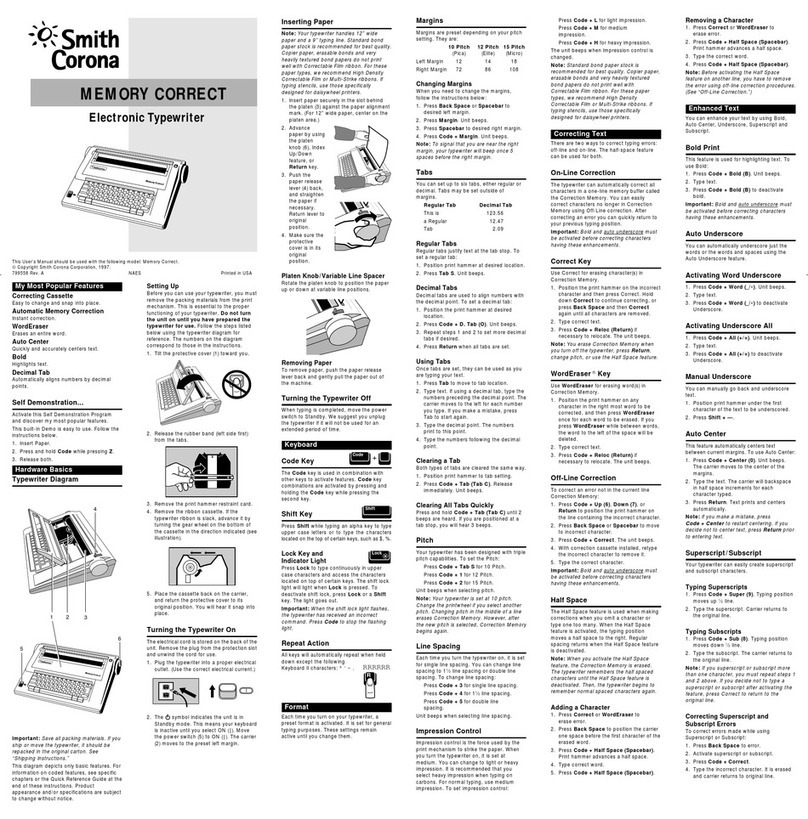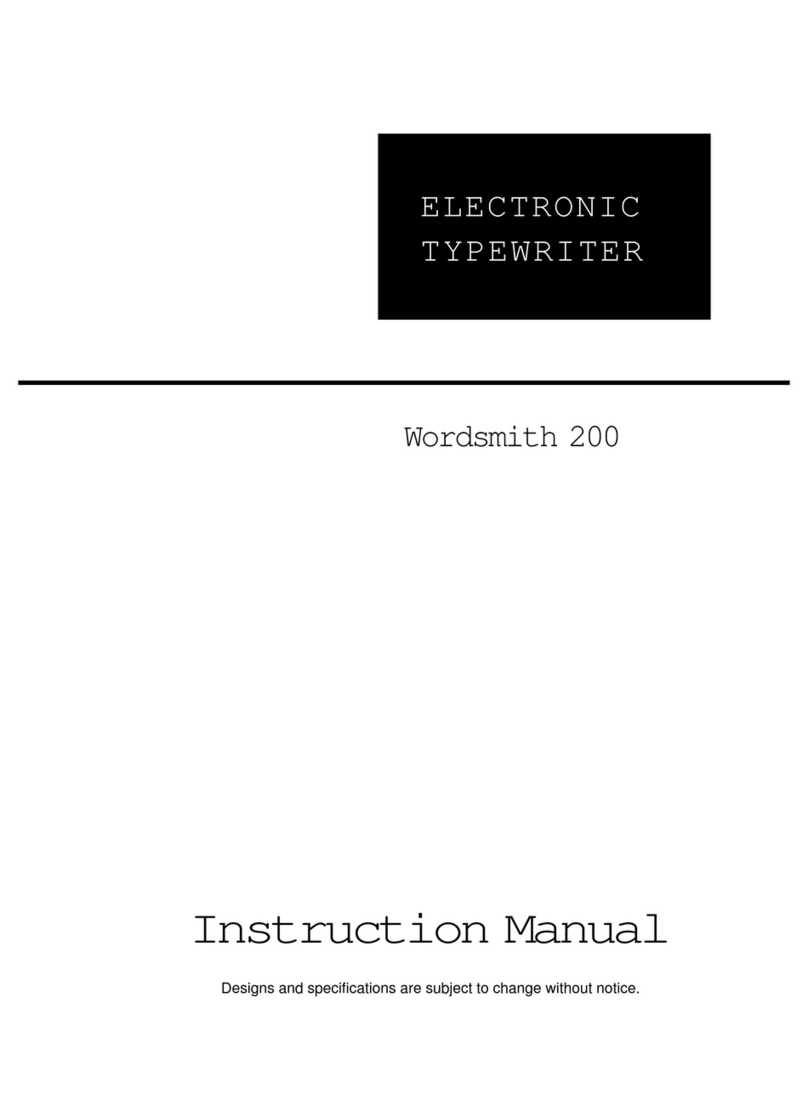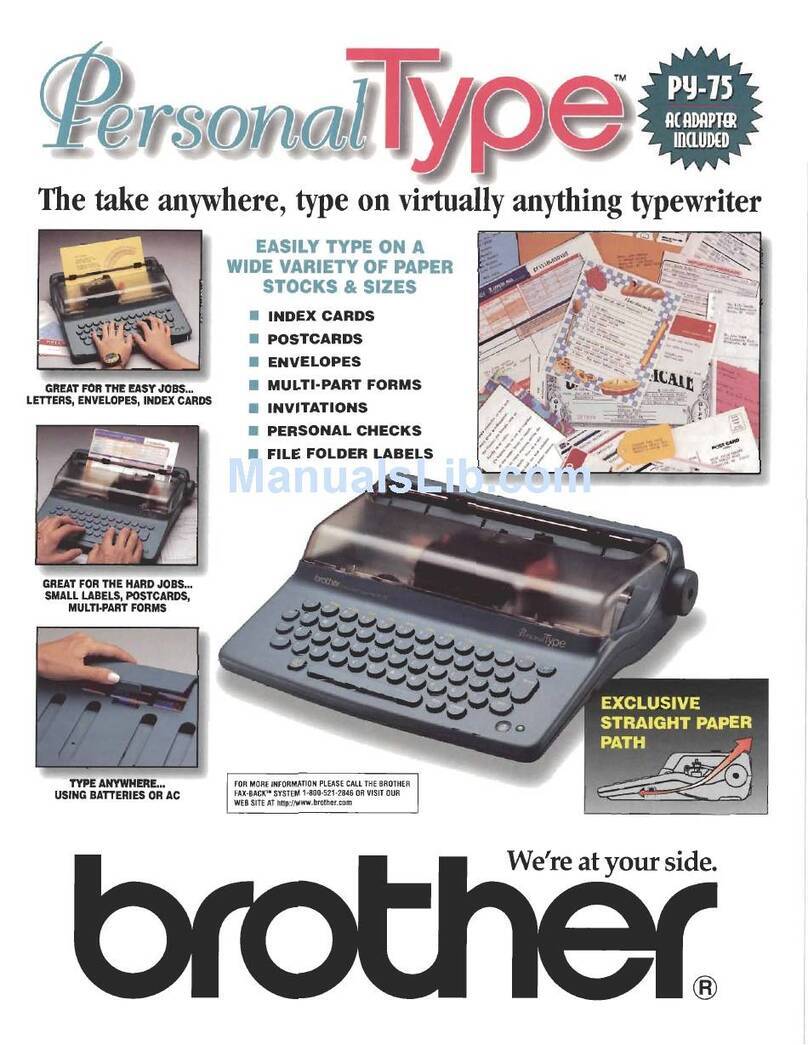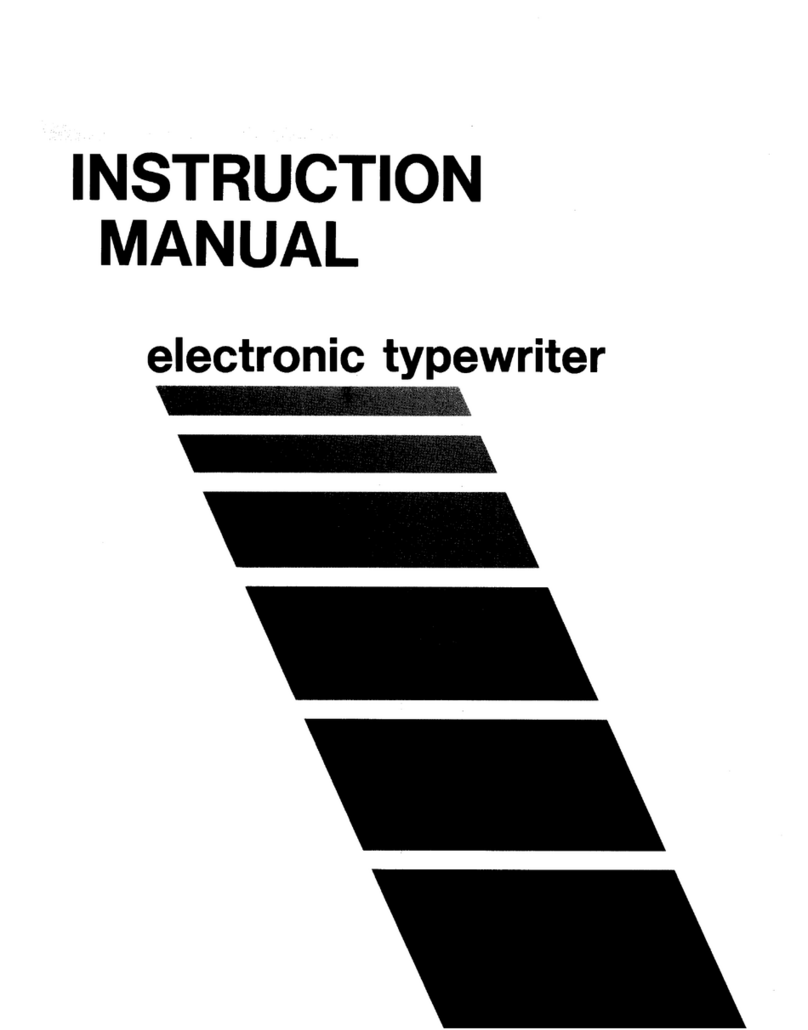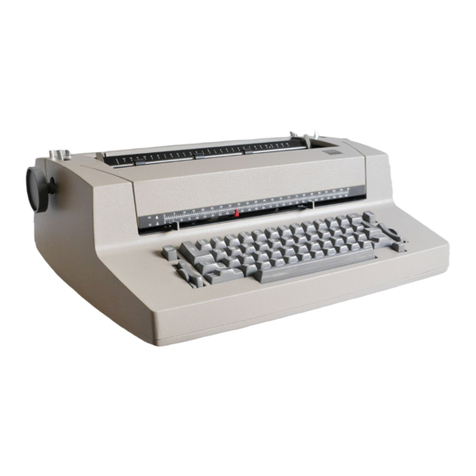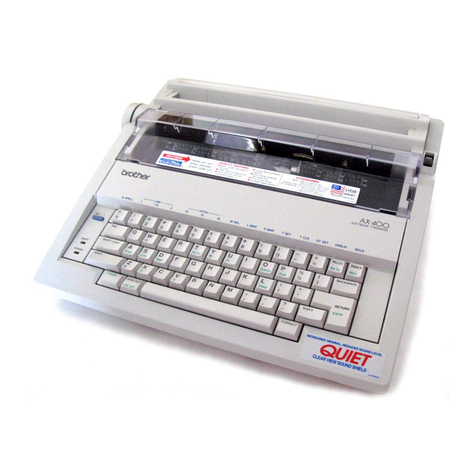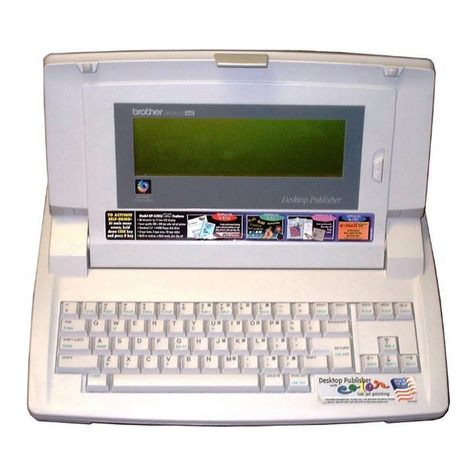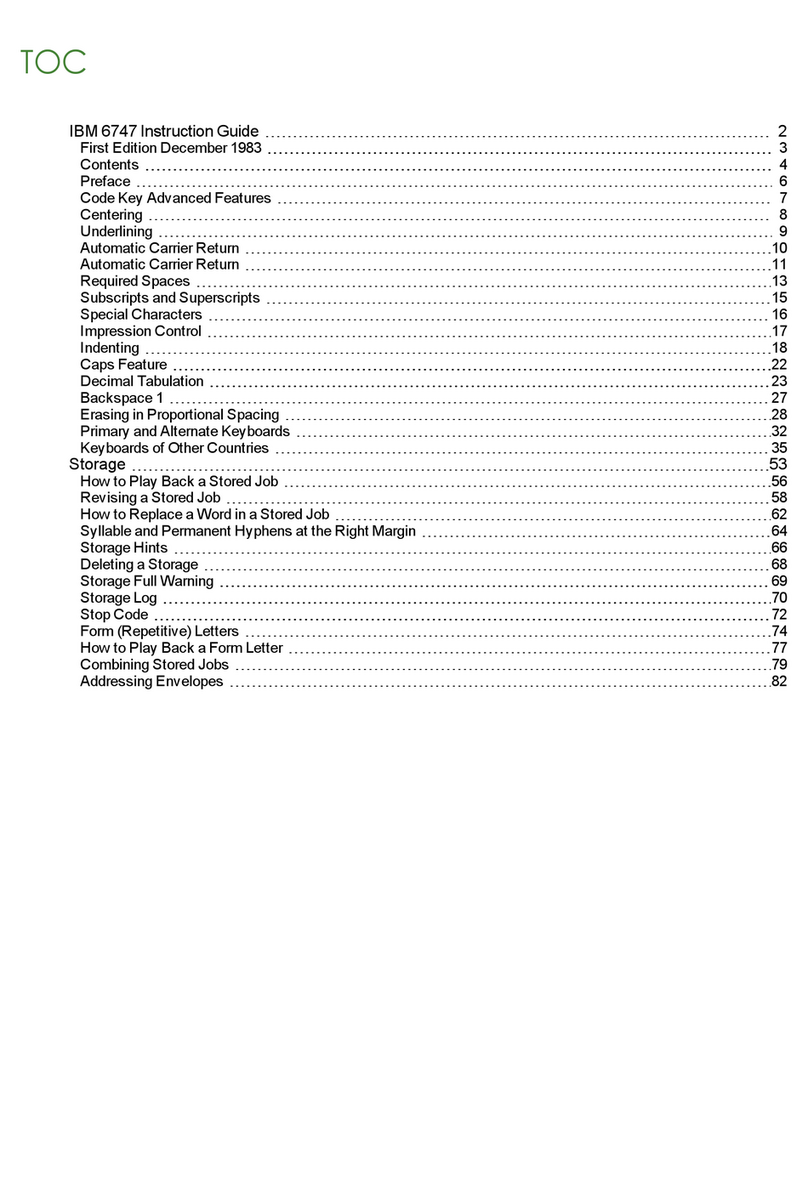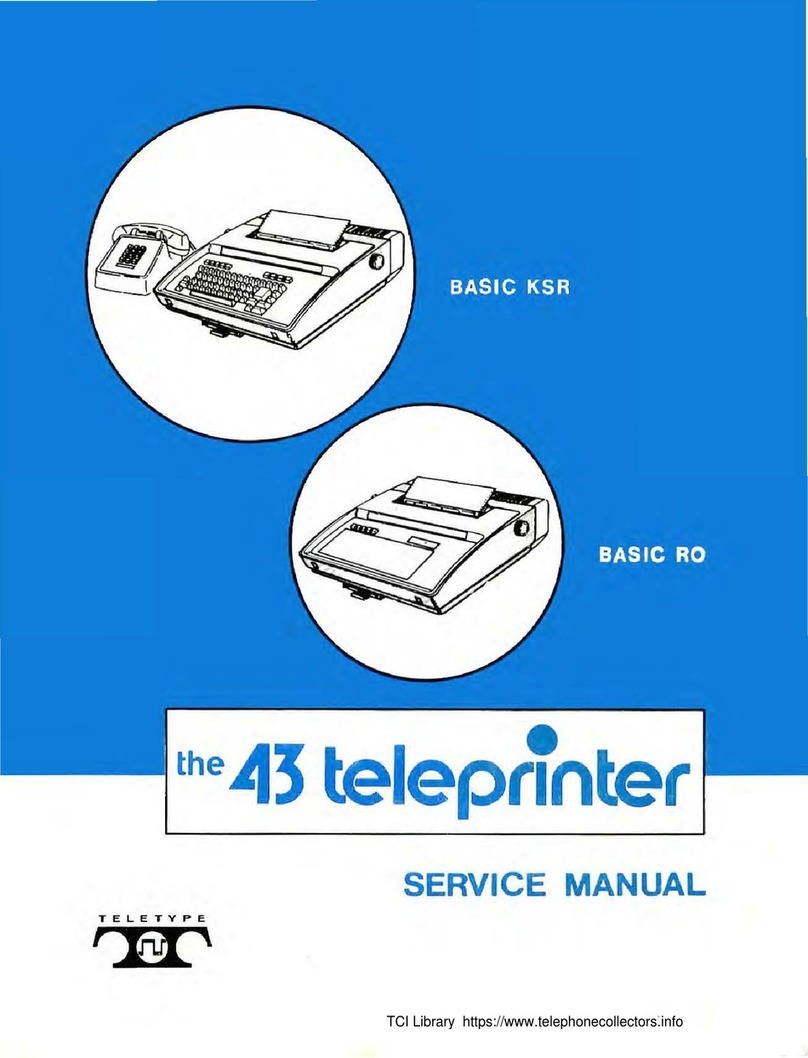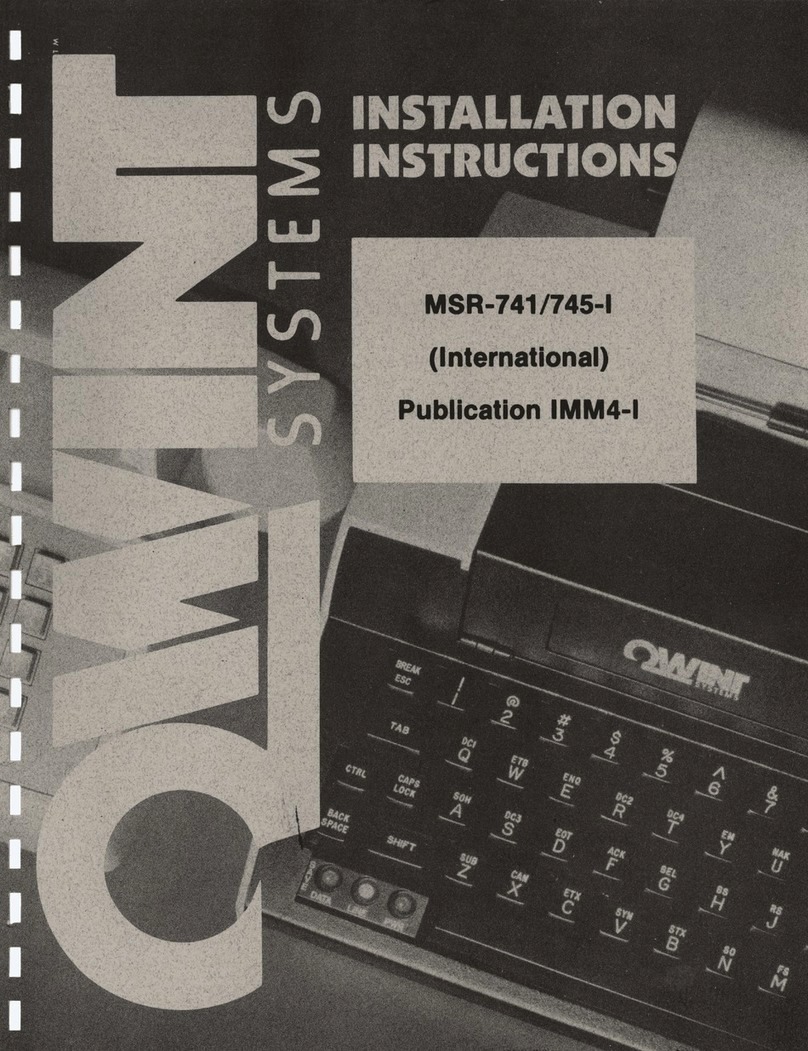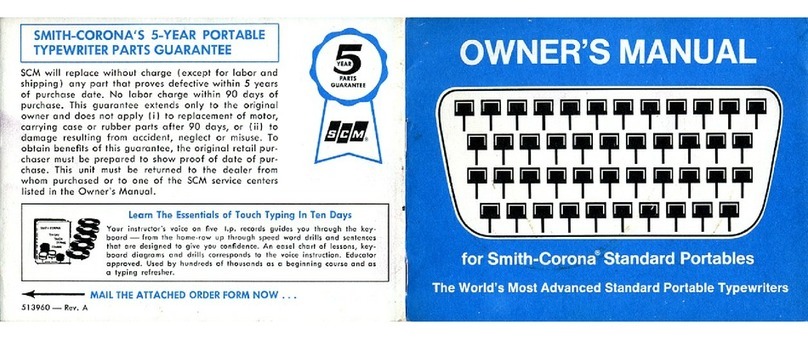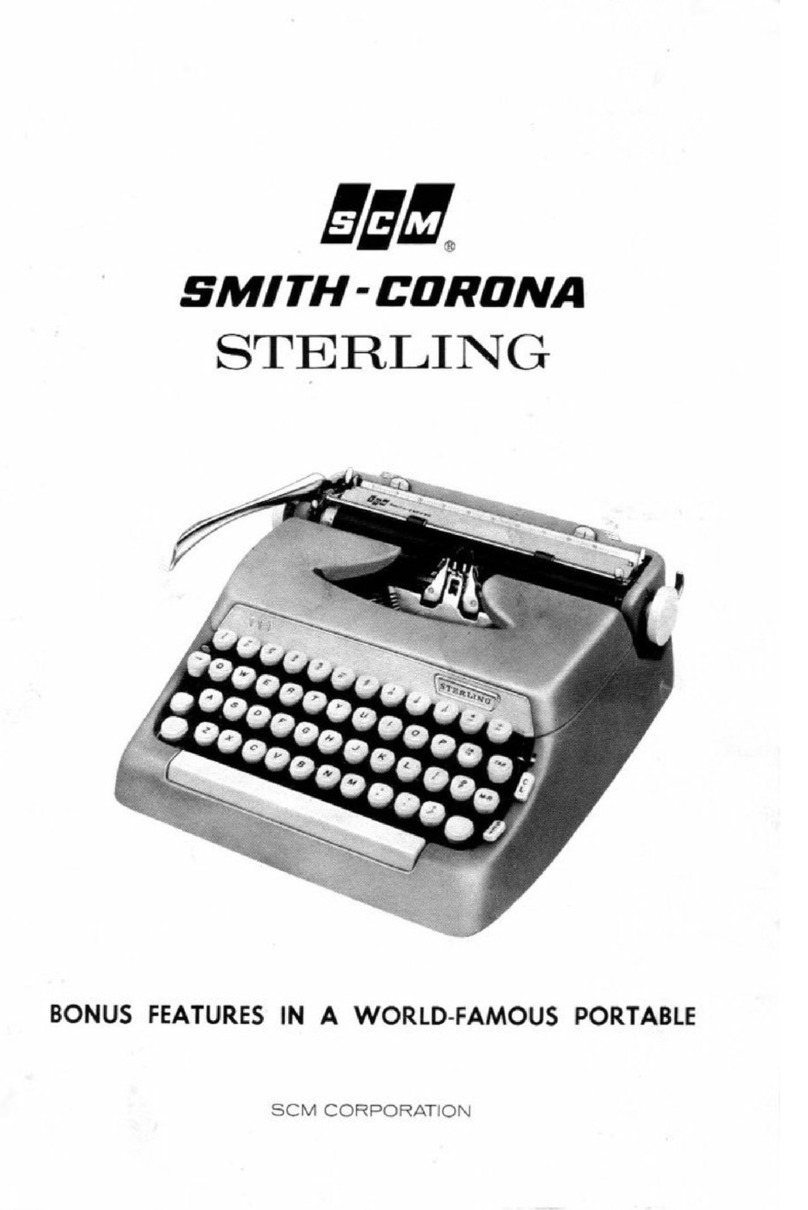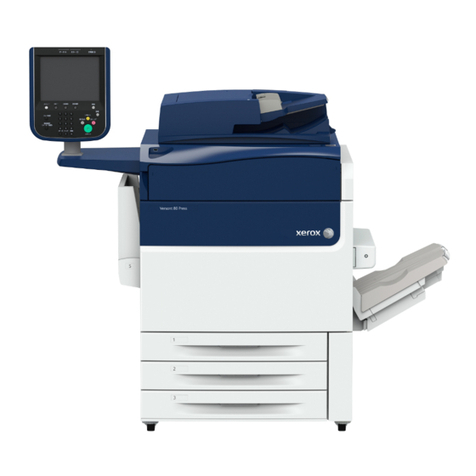Singer 1501 Specifications

OPERATOR
INSTRUCTIONS
SINGER
MODEL
1501
INTELLIGENT TERMINAL
SINGER
BUSINESS
MACHINES

OPERATOR
INSTRUCTIONS
SINGER
MODEL
1501
INTELLIGENT
TERMINAL
22-6504-01
AUGUST
1975
SINGE;R
BUSINESS
MACHINES
.
PRIN~£D
IN
;U.S.A.

REVISION
RECORD
Edition
Letter Suffix Description
None
00 Original Printing -
August
1975
"
" " ,
"
, .
Operator Instructions 8/75

SECTION
1
2
3
4
INTRODUCTION
. . . .
GENERAL
DESCRIPTION
OPERATOR
CONTROL
pANELS
OPERATING
PROCEDURES
..
...•
3-1.
Scope
of
this
Section
3-2.
3-3.
Inspection of the
Terminal
Application of
Power
...
3-4.
Loading
a
Tape
Cartridge .
3-5.
Normal
Operation
•...
3-6. Unloading a
Tape
Cartridge
3-7.
3-8.
Removal
of
Power
Error or
Check
Conditions
3-9.
Tape
Errors
OPERATOR
MAINTENANCE
• . • . •
4-1. General Information
4-2.
Tape
Drjve Cleaning
4-3.
4-4.
Leader
Replacement
Freeing a
Jammed
Loader
i
CONTENTS
PAGE
iv
1-1
2-1
3-1
3-1
3-1
3-1
3-1
3-3
3~3
3-4
3-4
3-6
4-1
4-1
4-1
4-5
4-9

CONTENTS
ILLUSTRATIONS
FIGURE
PAGE
1-1
Singer
Model
1501
Intelligent
Terminal. • • . • • . • • •
..
1-1
2-1
Location of the
Power
On/Uff
Switch
· · · · · · · ·
2-2
2-2
Location of the
Switch
Well
· · · .
2-2
2-3
Keyboard
Layout
. . . . · . · · · ·
2-2
2-4 Controls
on
the
Tape
Drive. · · · ·
2-3
2-5
Tape
Cartridge • . . . . · . . . · · ·
2-4
2-6
Tape
Cartridge with Cartridge
Cap
2-4
4-1
Releasing the
Loader
Retainer
Lock
4-2
4-2
Seri
es
1500
Tape
Dri
ve
• · · · · · · · · · 4-3
4-3
Removing
the
Leader
Eyelet • . · · ·
~-~
4-4 Cleaning the
Capstan
After
Leader
Removal
· · · · 4-4
4-5
Removing
the
Leader
Clip
From
the Clip
Channel
. · · · · · · · 4-5
4-6
Inserting the Leader Eyelet in the Clip
Channel
· · · · · 4-6
4-7 Connecting the
Leader
Eyelet to the Post
on
the
Clip.
4-7
4-8
Moving
the Clip into the
Channel
4-7
4-9
Leader
Shown
in
Tape
Path 4-8
4-10
Fre~ing
a
Jammed
Loader
· . . · · · · ·· · 4-9
ii

TABLE
3-1
CONTENTS
TABLES
Error or
Check
Conditions
••••••••••••.•.••.
iii
PAGE
3-5

INTRODUCTION
This
manual
provides the operating instructions for the
Model
1501
Intelligent
Terminal.
It
includes the following information:
SECTION
1
GENERAL
DESCRIPTION,
which
provides a
brief
description
of
how
the
equipment
functions
from
the viewpoint of
an
operator
and
identifies
all
major
parts of the equipment.
SECTION
2
OPERATOR
CONTROL
PANELS.
This section
shows
the location
and
appearance of
all
operator controls.
It
also
briefly
describes
what
each
control
does
when
it
is
operated.
SECTION
3
OPERATING
PROCEDURES.
Included in
this
section are the
step-by-step procedures required to operate the
machine.
This
section
does
not include instructions
that
are provided with the
operating
programs.
It
does,
however,
include a
list
of
error
conditions
and
the
checks
to
be
made
to correct
them.
SECTION
4
OPERATOR
MAINTENANCE.
Routine maintenance functions to
be
performed
by
the operator
and
the procedures to
perform
them
are
provided in
this
section.
iv

SECTION
1
GENERAL
DESCRIPTION
The
Singer
Model
1501
Intelligent
Terminal
shown
in figure
1-1
is
a
com-
pact desk-top
unit
that
provides
all
the functions
of
a mini-computer.
It
houses a
keyboard
slmi1ar to
that
of a typewriter, a display screen
for
efficient
fi11-in-the-b1ank type
of
data
entry,
two
tape drives
that
can
serve
as
either
input or output
units,
and
a
memory
that
stores the
program
that
controls operation of the
1501.
Various, wide-ranging
functions
can
be
obtained
by
simply loading
different
pre-recorded
program
tapes
and
following the
instructions
given
by
the
program.
Operator controls other than the
keyboard
include power-on, system
reset,
program
load,
and
program
interrupt
switches. Notification of data entry
errors
is
both visual
on
the display screen
and
audible through a speaker
in the keyboard
section.
Figure 1-1. Singer
Model
1501
Intelligent
Terminal
1-1

SECTION
2
OPERATOR
CONTROL
PANELS
The
Model
1501
Intelligent
Terminal
has
relatively
few
operator controls
aside
from
the keyboard.
The
function of these controls
is
described in
the table
below,
and
their
location
is
as
follows:
a.
The
power
on/off switch
is
located
on
the
right
side panel, as
shown
in figure 2-1.
b.
A
well
beneath the display screen houses the
PROGRAM
LOAD/PROGRAM
INTERRUPT
and
the
SYSTEM
RESET
switches,
which
are
shown
in
figure 2-2.
c.
The
keyboard,
which
is
similar in layout to
that
of a typewriter
supplemented
by
the addition of
some
special purpose keys,
is
shown
in figure 2-3.
d.
On
each
tape drive, there
is
a
manual
rewind
switch located
between
the supply
and
take-up
reels.
There
is
also a cartridge lock
lever,
which
;s
used
to lock the tape cartridge in place.
The
location of
these controls
is
shown
in figure 2-4.
Control
Keyboard
PROGRAM
LOAD
Switch
PROGRAM
INTERRUPT
Switch
and
SYSTEM
RESET
Switch
Rewind
Button
Power
on/off
Function
Data
entry
and
various functions
deter-
mined
by
program
Enables operator to load a
program
from
the tape in drive 2 (Switch forward for
program
load)
Used
when
called for
by
specific
programs
Rewinds
tape into cartridge
Controls
AC
power
to the
1501
(Switch·
up
for
power
on)
2-1

OPERATOR
CONTROL
PANELS
Figure 2-1. Location of the
Power
On/Off
Switch
Figure 2-2. Location of the
Switch
Well
Figure 2-3.
Keyboard
Layout
2-2

OPERATOR
CONTROL
PANELS
CARTRIDGE
REWIND
LOCK'LEVER
BUTTON
Figure 2-4. Controls
on
the
Tape
Drive
Operation of the
Model
1501
Intelligent
Terminal requires handling of the
tape
cartridges.
This snap-in
cartridge,
which
is
shown
in figure 2-5,
contains
100
feet
of
computer
grade tape
on
a floating inner
reel,
and
is
a storage device
used
with
all
Series
1500
Intelligent
Terminals. A
clear
outer case
fully
encloses the inner tape
reel.
located
on
the outer case
is
a two-position hole for the write pin.
If
the write pin
is
inserted into the position
on
top of the
cartridge,
the
tape cannot
be
written on.
If
the write pin
is
inserted into the position
on
the
bottom
of the
cartridge,
the tape
may
be
written on;
this
is
called
the IIwrite-enable
li
position.
It
is
important
that
the tape
be
fully
rewound
within the cartridge before
the tape
is
loaded or the
cartridge
removed
from
the tape drive.
The
tape
leader eyelet
must
be
in the position
shown
in figure
2-5
before the tape
is
loaded.
Cartridge caps are supplied with
each
cartridge
to prevent the
eyelet
from
vibrating out of position during shipping.
To
remove
the cap, simply
pry
it
off
with
fingertips.
To
install
a cap,
push
cap
into place
on
the
bottom
side of the tape
cartridge.
Turn
the
cap
in direction
of
arrow to
rewind
loose tapes.
(See
figure 2-6.)
2-3

OPERATOR
CONTROL
PANELS
Figure 2-5.
Tape
Cartridge
Figure 2-6.
Tape
Cartridge with Cartridge
Cap
2-4

3-1.
SCOPE
OF
THIS
SECTION.
SECTION
3
OPERATING
PROCEDURES
This section contains the procedures for operating the
Model
1501
Intelligent
Terminal
up
to the point
at
which
the
program
provides
further operating instructions. Steps to
be
taken
and
checks
to
be
made
by
an
operator
when
errors or malfunctions occur are also included in
this
section.
Do
not attempt to perform
any
step
that
is
not clear to
you;
ask
your supervisor, sales engineer, or
field
service representative
to explain the procedure to you.
3-2.
INSPECTION
OF
THE
TERMINAL.
Inspect the terminal before using,
as
follows:
a.
Make
sure
that
I/O
cabling
is
connected
and
terminator
(if
any)
is
in
place correctly.
b.
Check
to see
if
the
power
cord
is
properly
plugged
in
and
any
other
cables
and
plugs are properly connected.
c.
Make
sure
that
the cooling airways are not blocked.
3-3.
APPLICATION
OF
POWER.
a.
Turn
the
power
on/off switch to the
on
(up)
position.
The
switch
is
located
on
the
right
side of the unit near the back.
b.
Listen for indication
that
the
fan
is
operating properly.
3-4.
LOADING
A
TAPE
CARTRIDGE.
Always
load the
first
program
tape cartridge
on
tape drive
2.
To
load a
tape, observe the following instructions
and
photographs:
a. After
opening
the access
cover,
move
the locking
lever to the unlock
position.
3-1

OPERATING
PROCEDURES
b.
Lift
the loader.
Thi
sis
called the cartridge
inser-
tion position.
c.
Insert
the tape cartridge
into tape drive
2.
Check
that
the position of write
pin
is
correct.
d.
Push
down
on
the loader
with the tape cartridge
inserted.
e.
Move
the locking lever to
the lock position,
and
close the access cover.
3-2

OPERATING
PROCEDURES
f.
Locate
the well beneath the visual display,
and
lift
the
well
access
cover.
g.
Move
the
PROGRAM
LOAD
switch
forward
to load the
program
from
the
tape,
and
close the access cover.
3-5.
NORMAL
OPERATION.
After the
program
has
been
loaded
as
a
result
of step (g) above, instruc-
. tions appear
on
the display screen.
Follow
these instructions until the
task
is
completed; then
unload
the tapes
and
turn
off
the
machine
as
described in the following paragraphs.
3-6.
UNLOADING
A
TAPE
CARTRIDGE.
Unload
a tape cartridge
as
follows:
a.
Open
the access cover and,
if
tape
is
not already
rewound
into the tape
cartridge~
push
the
rewind
button.
b.
Move
th~
locking lever to
the
unlock
position.
c.
Lift
the loader
3-3

OPERATING
PROCEDURES
d.
Remove
the tape cartridge.
e.
Push
down
the loader with
tape cartridge
removed.
f.
Keep
the locking lever in
the
unlock
position to
keep
leader in place,
and
close
the access cover.
3-7.
REMOVAL
OF
POWER.
a.
Turn
the
power
on/off switch to the
off
(down)
position.
The
switch
is
located
on
the
right
side
panel
near the back.
b.
Refer to Section 4 of
this
manual
and
perform
all
necessary operator
maintenance procedures.
3-8.
ERROR
OR
CHECK
CONDITIONS
There
are several steps
that
an
operator
can
take to correct
minor
prob-
lems
that
occur during
normal
operation of the
Model
1501
Intelligent
Terminal.
Table
3-1
lists
some
of these
problems
and
the action
that
can
be
taken.
3-4

Symptom
Cooling
fan
not
rotating
and
no
lights
on
tape
dri
ves
Line
fuse
blows
continually
Program
does
not
load
Burning
odor
Failure during
program
Display
is
blank
Read
and/or write
errors
Leader
has
trouble
returning to
"home"
position
Tape
runaway
OPERATING
PROCEDURES
Table 3-1. Error or
Check
Conditions
Possible
Cause
1.
AC
line fuse
blown
2.
AC
line
cord loose
3.
AC
power
on/off
switch not
on
1.
Wrong
size fuse
2.
Internal defect
1.
Tape
cartridge
installed
improperly
2.
PROGRAM
LOAD
switch
defective
Burned
Component
Undetermined
Program
did not
load
1• Dirty read
head
2. Dirty write
head
1• Dirty capstan
2. Faulty leader
1•
Broken
leader
2.
Broken
tape
3-5
Action to
be
Taken
Replace
fuse.
Check
line
cord.
Turn
switch
on.
Check
fuse rating
Call service representative.
Check
Tape
Loading
procedure.
Retry
PROGRAM
LOAD
switch
Turn
power
off
and
call
service representative
Retry
program
Retry
program
load
Follow
directions
under
read/write errors.
Clean
capstan.
Replace
leader.
Follow
directions
under
tape
runaway

OPERATING
PROCEDURES
3-9.
TAPE
ERRORS.
Tape
errors
may
occur
if
preventive maintenance
is
inadequate.
If
a tape
error
occurs, the tape read or write operation
may
have
to
be
aborted,
depending
on
the type of
error.
The
two
major
error
classes are the
following:
Tape
Runaway.
If
both tape
reels
ever spin uncontrollably
at
high speeds, turn
power
off
immediately. There are
two
possible causes.
In
all
cases
it
is
recommended
that
the
entire
program
be
reattempted.
a.
If
the leader breaks, a tape
runaway
occurs.
Replace
the leader,
using the procedure in Section 4 of
this
manual.
b.
If
the tape breaks, a tape
runaway
occurs.
Replace
the tape
cartridge,
and
refer
to the procedure for freeing a
jammed
loader in Section 4 of
this
manual.
Read/Write Errors.
This type of
error
is
accompanied
by
an
error
tone.
If
read
error
occurs
while loading a
program
tape, depress the
red
rewind
button in the middle
of the tape drive.
The
program
tape, or the
copy
of the
program
tape,
may
be
reloaded
after
the cause of the
error
is
determined
and
corrected.
For
read/write
errors
with data tapes, the current
program
should
be
completed
and
later
reattempted.
The
cause of the read/write
error
must
be
determined. Depressing the
ERROR
key
will quiet the
error
tone.
Possible causes of read/write
errors
include the following:
a.
On
a tape write operation, the write pin
was
not in the
bottom
cartridge position.
b.
Dirt
on
the read/write heads, caused
by
inadequate preventive
maintenance.
c.
Wrinkled
tape.
d.
The
leader threading
was
not aligned in the proper grooves of the
tape guides.
3-6

OPERATING
PROCEDURES
The
corrective action to
be
taken for read/write
errors
is
as follows:
a.
If
unable to write
on
a tape,
check
the position of the write pin.
It
must
be
in the
bottom
position
on
the
cartridge.
Retry
this
operation.
b.
Check
the leader threading path
and
inspect the leader. Replace the
leader
if
necessary
by
following the leader replacement procedure in
Section 4 of
this
manual.
c.
Follow
the tape drive cleaning procedure in Section 4 of
this
manual
if
solutions (a)
and
(b)
above
do
not apply.
3-7

4-1.
GENERAL
INFORMATION.
SECTION
4
OPERATOR
MAINTENANCE
The
Model
1501
Intelligent
Terminal should
be
given the care worthy
of
any
high-quality piece of
electronic
equipment.
Dust
the cabinet,
keyboard,
and
display screen regularly with a clean,
soft
cloth.
Foreign material
such
as
coffee or
candy
should
be
removed
with a cloth
dampened
with a mild detergent or Freon.
Keep
the
keyboard
free of
metallic objects
such
as
paper
clips
and
hairpins, since these items
can
easily
cause
jamming
of the
keys
or
electrical
shorts
if
they
drop
through into the electronic
circuits.
Other than the overall cleaning outlined above, the only preventive
maintenance required of the user
is
to clean
all
tape drives
at
least
once
each
week,
using the procedure in
this
section. Inspect the tape
leader
each
time the tape drive
is
cleaned,
and
replace
it
as necessary.
The
inspection
and
replacement procedures are included in
this
section.
4-2.
TAPE
DRIVE
CLEANING.
Perform
the following steps to clean each tape drive:
a.
The
first
step
is
to
move
the loader to the upright position, as
follows:
(1)
Move
the locking lever to the unlock position
and
lift
the
loader to the
cartridge
insertion position.
If
the loader
cannot
be
raised, perform the steps in paragraph 4-4 before
performing the following step.
(2) Firmly pull the loader
retainer
lock with a forefinger,
as
shown
in figure 4-1,
and
lift
the loader.
(3)
Now
that
the loader
is
in the upright positio'n, take time to
become
familiar with the various
components
on
the tape drive,
as
shown
in figure 4-2.
Note
the threading path of the leader.
b.
Lift
the leader eyelet
upward
off
the pin
on
the take-up
reel,
as
indicated in figure 4-3.
The
leader
clip
will
remain
in the
clip
channel because the locking lever
is
in the unlock position.
c.
Remove
the leader
from
its
path.
If
the leader
has
worn
spots or
is
twisted, replace
it
as
described in the leader replacement procedure
in
this
section.
4-1
Other manuals for 1501
1
Table of contents
